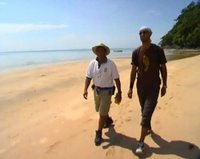I hear the "Call of the Wild"!
- published 11/12/14 Daily Mirror, Sri Lanka.
https://www.facebook.com/theMANonFIRE
- published 11/12/14 Daily Mirror, Sri Lanka.
https://www.facebook.com/theMANonFIRE
 I had travelled all this way for one reason - well a number of reasons actually - but the number one priority was to time our visit to coincide with the arrival of female green turtles, coming ashore to lay their eggs.
I had travelled all this way for one reason - well a number of reasons actually - but the number one priority was to time our visit to coincide with the arrival of female green turtles, coming ashore to lay their eggs.
 Fortunately our visit was timed almost to the last minute - the night we arrived, 7 turtles came ashore, and I was introduced to them by my guide, Christopher Kri, a local conservationist and all-round good bloke working for the Sarawak Forestry Board. Picture the scene: our tiny beach floodlit by a full moon; the waves sparkling under moonlight and not a sound from any of us, as we waited and waited.
Fortunately our visit was timed almost to the last minute - the night we arrived, 7 turtles came ashore, and I was introduced to them by my guide, Christopher Kri, a local conservationist and all-round good bloke working for the Sarawak Forestry Board. Picture the scene: our tiny beach floodlit by a full moon; the waves sparkling under moonlight and not a sound from any of us, as we waited and waited. Turtles are easily disturbed during their ponderous movements along the beach. It doesn't take much for them to turn tail and head back to the safety of the water.
Turtles are easily disturbed during their ponderous movements along the beach. It doesn't take much for them to turn tail and head back to the safety of the water.
 Because of the highly endangered status of the species in this part of the world, each nest is transferred, as soon as the female departs, to the safety of an enclosed hatchery, where the eggs are protected from predators and poachers. Around 58 days later, the babies hatch, and the forestry staff give them a personal escort back to the sea - in hopes that they will return here to lay the foundations for the next generation, some thirty years later...
Because of the highly endangered status of the species in this part of the world, each nest is transferred, as soon as the female departs, to the safety of an enclosed hatchery, where the eggs are protected from predators and poachers. Around 58 days later, the babies hatch, and the forestry staff give them a personal escort back to the sea - in hopes that they will return here to lay the foundations for the next generation, some thirty years later... David Attenborough's calm and composed presentation struck home far stronger than any modern-day 'reptile hunter'; compelling me to think further than the shores of England, further than the physical constraints of the tired old elephants of London Zoo.
David Attenborough's calm and composed presentation struck home far stronger than any modern-day 'reptile hunter'; compelling me to think further than the shores of England, further than the physical constraints of the tired old elephants of London Zoo.
 That's what it felt like - to be standing on a landscape, so spellbinding, and yet so alien - that it almost felt unreal to actually be there.
That's what it felt like - to be standing on a landscape, so spellbinding, and yet so alien - that it almost felt unreal to actually be there.
